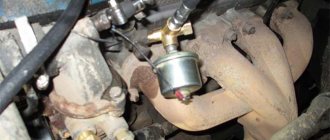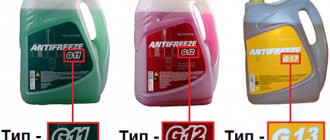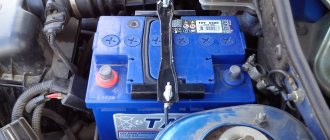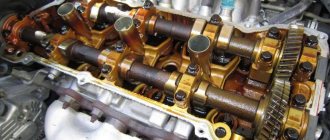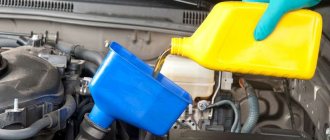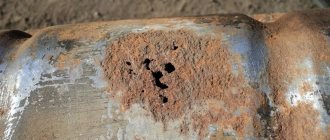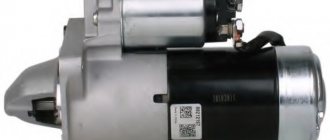- home
- Brands
- VAZ
24.05.2020
VAZ-2106 is a family of Soviet and Russian rear-wheel drive cars, presented on the market from 1976 to 2006. It is a continuation of the development of model 2103. The sedan of the same name was produced in Tolyatti, Izhevsk and Ukraine. The total production volume for all time amounted to 4.3 million copies. The car was equipped with a 1.6 petrol engine (78 hp), created on the basis of the 1.5 engine from 2103. In addition, a 63-horsepower 1.3-liter engine was also available. As of 1983, the VAZ-21063 cost 8,200 rubles, and the 2106 version was sold for 8,400 rubles.
Oil change period in the VAZ 2106 engine
When dealing with a used VAZ-2106 car, it is important to remember the annual oil change schedule, or every 10 thousand km. At the same time, it is also important to take into account the condition of the lubricant, which can be determined by the level of the liquid, its color and smell. If the corresponding signs are detected (turbidity, burnt smell, metal shavings and wear products in the form of sediment), the oil must be urgently replaced. This may need to be done after 6 thousand km, which is usually relevant for harsh operating conditions (sharp starts and braking, aggressive driving and non-compliance with traffic rules, driving on dusty roads and slushy terrain, towing heavy trailers, etc.).
Transmission oil
Finally, let's take a look at the transmission. In VAZ classic models, lubricant is poured into the gearbox and gearbox, and starting from the VAZ-2108 model and higher - only in the gearbox (they do not have a gearbox). Moreover, these units use a special oil - transmission oil. This lubricant does not require replacement as often as power plant lubricant, and the general requirements for it are much lower.
Related link:
Instructions for buying a new car
When choosing VAZ-2107 transmission oil for the winter, you don’t really need to take into account the nuances. Transmission elements use oils with SAE classification index 75W-85, 80W-90, etc. It is poured into both the gearbox and gearbox.
The same oil is used in more modern VAZ models. To more accurately select transmission oil for a particular car, it is better to find out in the operating instructions what kind of lubricant is needed.
How much oil to pour into the VAZ 2106 engine
First generation 2106, 1975-2006
The VAZ-2106 was a modernized three-ruble car. The developers decided to slightly reduce the cost of the car's appearance by getting rid of unnecessary chrome elements. As a result, the car received new bumpers and front fascia, different rear lights and other minor external improvements. In addition, there are new door cards inside, as well as a hazard warning button on the front panel. After 1987, a 5-speed manual transmission began to be installed instead of a manual transmission-4, and in the 1990s the design and interior were significantly simplified - metal elements were replaced by plastic parts to reduce the cost of production. But the car received a heated rear window, a contactless ignition system, halogen headlights and new seat upholstery. In the last years of production, the 2106 was offered with an 80-horsepower 1.6-liter injection engine.
Also read: Motor oil for BMW M54 engine
Gasoline engines 1976-2001
- 1.3 64 l. With. (21011), oil volume - 3.75 liters, tolerance and viscosity: API-SG, SJ, SH; SAE 5W-30, 10W-40, 10W-30, 5W-40
- 1.45 73 l. With. (2103), oil volume - 3.75 liters, tolerance and viscosity: API-SG, SJ, SH; SAE 5W-30, 10W-40, 10W-30, 5W-40
- 1.6 76 l. With. (2106), oil volume - 3.75 liters, tolerance and viscosity: API-SG, SJ, SH; SAE 5W-30, 10W-40, 10W-30, 5W-40
AvtoVAZ experiments
The gasoline engine of the VAZ-2106 has passed many tests. The plant conducted experiments with it, among which a special place was given to finding the best motor oil for it.
A specific lubricant was never found, because a whole group of suitable fuels and lubricants was discovered.
Using the SAE J 300 viscosity classification of oils accepted throughout the world, AvtoVAZ employees identified two types of oils - “Standard” and “Super”. So, for the VAZ car of the model in question, it is better to use “standard lubricants”. The technical requirements for them are set out in the draft TTM 1.97.0715-99 and RD 3148.37.101.001-2001. The last numbers mean nothing more than the years - 1999 and 2001.
More than a decade has passed since then, and many new oils have appeared on the Russian market, the appearance of which no one could have predicted. Most of the lubricating fluids taken as a basis in those years exist and are widely used to this day. They show themselves especially worthy in VAZ 2106 engines produced before October 1, 2000, where oil changes are performed every 10 thousand km, and even more often in winter.
The lubricants of the “Standard” group include the following products from various manufacturers:
It is no secret that all of the above oils are produced in Russia and only one is produced in Ukraine. In general, AvtoVAZ tested on the 2106 engine exclusively products manufactured in the territory of the post-Soviet space. The trouble is that many motorists are accustomed to trusting foreign analogues. In some ways they are right, because European and American car cosmetics have always been considered the best, not without reason. Today there is more than enough of it in our market, which is why it is worth considering what kind of motor oil other motorists pour into their “sixes”. Return to content
What oil to use for the VAZ 2106 engine
Original
VAZ-2106 owners use mineral, semi-synthetic or synthetic oil. Semi-synthetic is considered the most popular for this model. Regarding SAE viscosity, it should be noted that this parameter is selected based on temperature conditions. For example, for year-round operation, a 10W-40, 10W-30 or 5W-40 all-season oil is recommended. In the winter season, it is better to fill in 0W-30, 0W-40 or 5W-30, and in the summer you can opt for 20W-40 or 25W-50.
Unoriginal
Owners of VAZ-2106 cars prefer inexpensive motor oils from domestic brands Lukoil, Rosneft, G-Energy and Gazpromneft. When choosing a suitable product, it is necessary to take into account the API approval, which is selected depending on the year of manufacture of the car, as well as the type of internal combustion engine. For example, for a gasoline VAZ-2106 produced in 1976. All-season mineral oil with parameters 15W-20 and API-SG is suitable. For cars of the 2006 model year, semi-synthetic API-SJ is recommended. Below are the best options for analogue motor oils for the VAZ-2106.
- ZIC X5 10W-40
- Lukoil Lux 10W-40
- Mobil Super 3000 5W-40
- G-Energy 10W-40
- Eneos 10W-40.
Characteristics of oils
Main classes of oils and their characteristics
Sooner or later, the owner of a used “six” will have a question: “When and what kind of oil should I fill in the VAZ-2106 engine?”, because what VAZ once recommended is no longer produced by our industry.
Modern lubricants are divided into three classes:
- Mineral;
- Synthetic;
- Semi-synthetic.
Mineral oils are made from petroleum using traditional methods and are characterized by their low cost and significant variation in viscosity at negative and positive temperatures. So at -20C, classic mineral oil becomes very thick, comparable in viscosity to plasticine. In fact, this is no longer lubricating or cleaning the engine, but simply a very viscous mass.
The raw materials for synthetic oils are butylene and ethylene gases contained in associated petroleum gas; “synthetics” not only have good viscosity-temperature characteristics, but are also expensive. Some brands have a pour point of -60C, which facilitates easy engine starting in severe frosts.
“Semi-synthetics” is a specially selected mixture of mineral and synthetic oils, hence the properties it has: relatively low cost with fairly good performance characteristics, over a wide temperature range
Marking according to the international standard SAE:
- "Mineral" - mineral;
- “Fully Synthetic” - synthetic;
- "Semi Synthetic" - semi-synthetic.
If on the packaging, after the abbreviation of the SAE standard, there are only numbers, then this lubricant is summer, if after the number there is a Latin “W” - winter, the combined use of numbers before and after the “W” indicates that this is an all-season oil, the first digit means - the degree of frost resistance, the lower the number, the higher the frost resistance, the second softness or hardness reduced to 100C, the higher this number, the hotter the climate the motor can operate.
Instructions
- We warm up the engine to 45-50 degrees. Warm oil has better fluidity and will drain better from the engine during a complete replacement. Our task is to remove as much as possible the old dirty and used fluid that no longer has useful properties from the engine and fill it with new one. If a lot of old dirty oil remains in the crankcase, it will be swept away with the new one and will worsen its beneficial properties. Warm up the engine for 5-7 minutes before starting, this will be sufficient.
- For easy access to the drain plug (and in some models the oil filter is also attached from the bottom) and the bottom of the car as a whole, you need to jack it up or drive into an inspection hole (the best option). Also, some models may have engine crankcase “protection” installed.
- We open air access to the crankcase by unscrewing the filler cap and dipstick.
- Place a large container (equal to the amount of oil being poured).
- Unscrew the drain plug with a wrench. Sometimes the drain plug is made like a regular “bolt” under an open-end wrench, and sometimes it can be unscrewed using a four- or hexagon. Don't forget to wear protective gloves, the oil will most likely wake you up warm, but you need to be careful.
- We wait about 10-15 minutes until the waste flows into a basin or cut-off plastic canister.
- Optional but very effective! Flushing the engine with a special liquid is not included in the maintenance regulations and is not mandatory - but. By getting a little confused, you will be much better at flushing out the old, black oil from the engine. In this case, wash with the old oil filter for 5-10 minutes. You will be surprised at the black oil that comes out with this liquid. This liquid is very easy to use. A detailed description should appear on the flushing fluid label.
- Changing the sedum filter. In some models, it is not the filter itself or the filter element (usually yellow) that is changed. Impregnating the filter with new oil before installation is a mandatory procedure. Lack of oil in the new filter before starting the engine can cause oil starvation, which in turn can cause filter deformation. Overall this is not a good thing. Also remember to lubricate the rubber O-ring before installation.
- Fill in new oil. Having made sure that the drain plug is screwed in and a new oil filter is installed, we can begin to fill in new oil using the dipstick as a guide. The level should be between the minimum and maximum marks. Also, you need to remember that after the first start of the engine, some oil will leave and the level will drop.
- In the future, when the engine is running, the oil level will probably change; be careful during the first few days of operation. Recheck the oil level using the dipstick after the first start.
